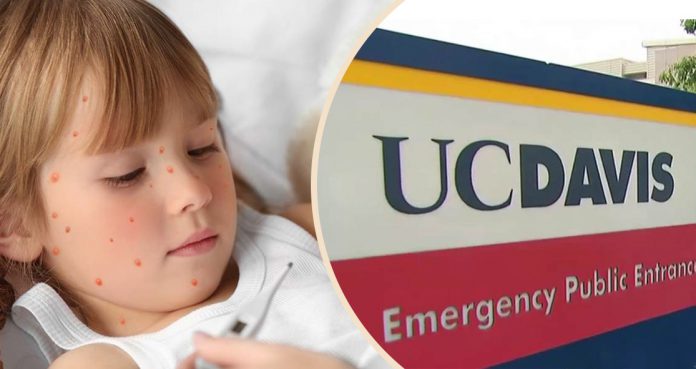UC Davis Medical Center, formerly known as Sacramento Medical Center, a large Northern California hospital has warned at least 200 people that might have been unintentionally exposed to measles by a child who visited ER with respiratory systems.
The 7-year-old girl was brought to the emergency room a couple of weeks ago with “some symptoms of measles, but not the typical textbook characteristics of measles,” said Dr. Dean Blumberg, chief of pediatric infectious diseases at the University of California, Davis, Children’s Hospital.
“Measles when it starts, starts off very similar to a lot of common community associated respiratory viruses,” explained the pediatrician.
In some children, Dr. Blumberg said, “The disease can start out with ‘fever, runny nose, runny eyes and cough.’ And before the characteristic rash develops, sometimes it can be very difficult to diagnose.”
The girl visited the ER on March 17 and she was suspected of having the disease on March 19. She was placed in appropriate isolation, said Dr. Blumberg.
Infected people can have measles for days without actually knowing it and may meet many others, spreading the disease before the symptoms are experienced.
Dr. Blumberg stated, “Most cases of measles occur eight to 12 days after exposure, but it can occur up to three weeks after exposure. Even vaccinated individuals can get measles because the vaccine is not 100 percent perfect. We need a very high vaccination rate because when measles is introduced to communities that have parents who don’t immunize their children, these clusters of cases can occur.”
In 2000, measles was considered to be eradicated in the U.S., which was a major public health victory.
According to the CDC estimation, nearly 400 to 500 people used to die each year due to measles, more than 48,000 hospitalizations were reported each year, and roughly 1,000 suffered from encephalitis, or brain inflammation.
As the anti-vaccine movement has grown, measles has once again started to appear. So far, this year, there have been more than 385 reported cases of measles in the U.S. across 15 states, according to the CDC. Many of the measles cases in 2019 have been clustered in six outbreaks, including Clark County, Rockland County, and New York. And this is largely because of a growing vaccine-hesitancy driven by misinformation campaigns, especially on social media.
According to the CDC, more than 91 percent of children aged 19 months to 3 years have received at least one dose of the MMR (mumps, measles
Roberto Cattaneo, a measles researcher from Minnesota, said, “With the drop in vaccination rates, we may be headed back in that direction. It seems that we may be approaching the level where measles could be considered again to be endemic in the United States.”
Cattaneo told NBC news, “One problem is that doctors may not recognize measles right away because they’ve never seen it. I think doctors now will be alarmed and go back to their books and get accustomed to what it looks like.”
Dr. Blumberg cautioned parents to call the hospital before arriving if they suspect that their kids might have measles so that the hospital staff can adequately prepare. “What we can do in those kinds of situations is let them in through the side door and place them immediately into an isolation room. We don’t want them in the waiting room where potential exposures may occur,” stated Dr. Blumberg.






















